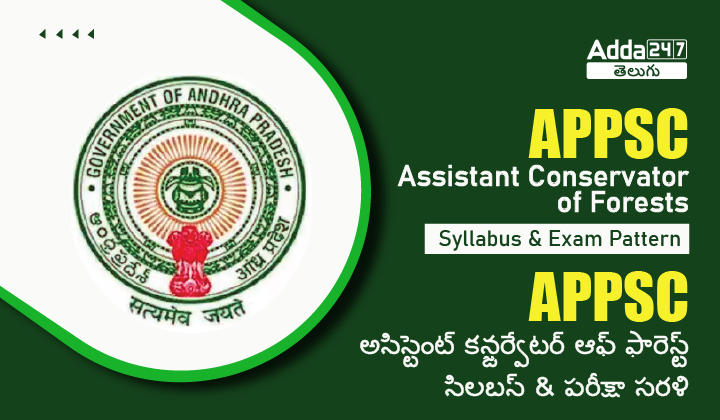APPSC ACF Syllabus 2023
APPSC ACF Syllabus : Andhra Pradesh Public Service Commission (APPSC) has released a notification for filling up of 09 Assistant Conservator Forests vacancies. In this article we are providing detailed Syllabus and Exam pattern of APPSC Assistant Conservator of Forests.
| Name of the Post | Assistant Conservator of Forests |
| Vacancies | 09 |
| Category | Syllabus & Exam Pattern |
APPSC ACF Syllabus & Exam Pattern
APPSC అసిస్టెంట్ కన్జర్వేటర్ ఆఫ్ ఫారెస్ట్ సిలబస్ & పరీక్షా సరళి: ఆంధ్రప్రదేశ్ పబ్లిక్ సర్వీస్ కమిషన్ (APPSC) 09 అసిస్టెంట్ కన్జర్వేటర్ ఫారెస్ట్ ఖాళీల భర్తీకి నోటిఫికేషన్ విడుదల చేసింది. ఈ కథనంలో మేము APPSC అసిస్టెంట్ కన్జర్వేటర్ ఆఫ్ ఫారెస్ట్ యొక్క వివరణాత్మక సిలబస్ మరియు పరీక్షా సరళిని అందిస్తున్నాము.
 APPSC/TSPSC Sure shot Selection Group
APPSC/TSPSC Sure shot Selection Group
APPSC ACF 2022 Overview (అవలోకనం)
ఆంధ్రప్రదేశ్ పబ్లిక్ సర్వీస్ కమిషన్ (APPSC) 09 అసిస్టెంట్ కన్జర్వేటర్స్ ఖాళీల భర్తీకి కొత్త ఖాళీ నోటిఫికేషన్ను విడుదల చేసింది. నోటిఫికేషన్ యొక్క పూర్తి సమాచారాన్ని దిగువ తనిఖీ చేయండి.
| Name of Organization | Andhra Pradesh Public Service Commission (APPSC) |
| Total Posts | 09 |
| Post Name | Assistant Conservator Forests |
| Qualification | Bachelor Degree |
| Job Category | Government Jobs |
| Apply Mode | Online Mode |
| Exam date | 9th November 2022 |
| Job Location | Andhra Pradesh |
| Official Website | https://psc.ap.gov.in/ |
APPSC ACF Exam Pattern (APPSC ACF పరీక్షా సరళి)
మొత్తం 600 మార్కులకు ఆబ్జెక్టివ్ విధానంలో నిర్వహిస్తారు. ఇందులో క్వాలిఫైయింగ్ పేపర్లు జనరల్ ఇంగ్లిష్ (50 మార్కులు), జనరల్ తెలుగు (50 మార్కులు). APPSC అసిస్టెంట్ కన్జర్వేటర్ ఫారెస్ట్ పోస్టు కోసం పరీక్షా విధానం దిగువన ఇవ్వడం జరిగింది.
| SCHEME FOR WRITTEN EXAMINATION (OBJECTIVE TYPE) DEGREE STANDARD | ||||
| Sl No. | Subject | Marks | Questions | Minutes |
|
1. |
General English (50 marks) & General Telugu (50 marks)
(To be Qualified in English & Telugu individually) |
100 Marks (Qualifying Test ) |
100 Questions |
100 Minutes |
| 2. | Paper-1: General Studies & Mental Ability | 150 Marks | 150 Questions | 150 Minutes |
| 3. | Paper-2: Mathematics (SSC standard) | 150 Marks | 150 Questions | 150 Minutes |
| 4. | Paper-3: General Forestry – I | 150 Marks | 150 Questions | 150 Minutes |
| 5. | Paper-4: General Forestry – II | 150 Marks | 150 Questions | 150 Minutes |
| Total | 600 Marks | |||
APPSC ACF Syllabus (APPSC ACF సిలబస్)
ఇక్కడ మేము సబ్జెక్టుల వారీగా సిలబస్ మరియు వివరణాత్మక పరీక్షా సరళిని అఅందిస్తున్నాము. కాబట్టి దరఖాస్తుదారులందరూ ఈ కథనాన్ని పూర్తిగా చదవాలని సూచించారు.
General English And General Telugu (Qualifying Test): Syllabus
General English Test ( 50 Marks)
- Comprehension
- Phrases and idioms
- Vocabulary and punctuation
- Logical re-arrangement of sentences
General Telugu Test ( 50 Marks)
- Synonyms & Vocabulary
- Grammar
- Telugu to English meanings
- English to Telugu meanings
Paper-1: General Studies & Mental Ability : Syllabus
- General Science – Contemporary developments in Science and Technology and their implications including matters of every day observation and experience, as may be expected of a well-educated person who has not made a special study of any scientific discipline.
- Current events of A.P state and national
- History of India – emphasis will be on broad general understanding of the subject in its social, economic, cultural and political aspects with a focus on AP and Indian National
- Indian Geography with a focus on AP.
- Indian polity and Economy – including the country’s political system- rural development –Planning and economic reforms in India.
- Mental Ability – Reasoning & Inference
- Sustainable Development and Environmental Protection
- Disaster Management-
- Concepts in disaster management and vulnerability profile of India and State of A.P.
- Earth quakes, Cyclones, Tsunami, Floods, Drought – causes and
- Manmade disasters – Prevention
- Mitigation strategies and measures
Paper-2: Mathematics : Syllabus
- ARITHMETICS:
- Number System-Natural numbers, Integers,
- Rational and Real numbers,
- Fundamental operations, addition, subtraction, multiplication, division, square roots, Decimal
- Unitary method-time and distance, time and work, percentages, applications to simple and compound interest, profit and loss, ratio and proportion,
- Elementary Number Theory – Division algorithm, Prime and composite Tests of divisibility by 2, 3,4,5,9 and 11.
- Multiples and factors, factorisation H.C.F. and L.C.M. Euclidean algorithm. Logarithms to base 10, laws of logarithms, use of logarithmic tables.
2. ALGEBRA:
- Basic Operations, simple factors, Remainder Theorem, C.F., L.C.M.
- Theory of polynomials, solutions of quadratic equations, relation between its roots and coefficients (Only real roots to be considered). Simultaneous linear equations in two unknowns – analytical and Graphical Simultaneous linear in equations in two variables and their solutions.
- Practical problems leading to two simultaneous linear equations or in equations in two variables or quadratic equations in one variable and their
- Set language and set notation, rational expressions and conditional identities, laws of indices.
3. TRIGONOMETRY:
Sine x, Cosine x, Tangent x when Oo = x = 90o values of sin x, cos x and tan x, for x= Oo , 30o, 45o, 60o and 90o, Simple trigonometric identities. Use of trigonometric tables, Simple cases of heights and distances.
4. GEOMETRY:
- Lines and angles, Plane and plane figures,
- Theorems on
- Properties of angles at a point,
- Parallel lines,
- Sides and angles of a triangle,
- Congruency of triangles,
- Similar triangles,
- Concurrence of medians and altitudes,
- Properties of angles, sides and diagonals of a parallelogram, rectangle and square,
- Circles and its properties including tangents and normals,
- loci
5. MENSURATION:
- Areas of squares, rectangles, parallelograms, triangle and
- Areas of figures which can be split up into the figures (Field Book),
- Surface area and volume of cuboids, lateral surface and volume of right circular cones and cylinders, surface area and volume of spheres
6. STATISTICS:
- Collection and tabulation of statistical data,
- Graphical representation – frequency polygons, histograms, bar charts, pie charts Measures of central tendency
Paper-3: General Forestry -I : Syllabus
- RENEWABLE AND NON-RENEWABLE NATURAL RESOURCES:
- Forest resources: Use and over-exploitation, deforestation, important case studies. Timber extraction, mining, dams and their effects on forests and tribal
- Water resources: Use and over-utilization of surface and ground water, floods, drought, conflicts over water, dams-benefits and
- Mineral resources: Use and exploitation, environmental effects of extracting and using mineral
- Food resources: World food problems, changes caused by agriculture and overgrazing, effects of modern agriculture, fertilizer-pesticide problems, water logging,
- Energy resources: Growing energy needs, renewable and non-renewable energy sources, use of alternate energy
- Land resources: Land as a resource, land degradation, man induced landslides, soil erosion and
II. PLANT SCIENCES:
- The diversity in the living world and biological
- Morphology of flowering plants-modifications and functions of roots, stems and leaves.
- Basics of plant tissues and how they differ from animal
- Basic anatomical structure of wood like annual rings, grain, texture, pores, fibers, pith, rays, ,
- Seed morphology- types of seeds viz., mono-cotyledonous and di-cotyledonous, albuminous and endospermic and their development, structure, dormancy, dispersal and
- Reproduction in plants:
- Sexual incompatibility and sexual methods of reproduction in plants-Pollination, fertilization, hybridization and development of the
- Asexual and vegetative methods of reproduction
- Principles of Plant propagation- production of varieties and
- Absorption and conduction of water and minerals salts translocation- transpiration – photosynthesis, respiration, digestion and assimilation of food, anabolism and catabolism- deficiency symptoms of essential elements, role of plant growth regulators in
- Basic principles of inheritance and variation and molecular basis of inheritance with special emphasis on DNA &
- The most common diseases of plants, important factors affecting infections and the chemical, biological and genetic methods of disease
III. BIODIVERSITY AND ITS CONSERVATION:
- Definition and value of biodiversity, genetic, species and ecosystem diversity,
- Biodiversity at global, National and local levels,
- Hot-spots of biodiversity, causes of biodiversity losses, need and the measures for biodiversity
- Major biomes of India, major abiotic factors that influence the life of organisms, responses of the organisms to such factors, adaptations for withstanding the extremes in the environment and population
IV. SOIL SCIENCE & GEOLOGY:
- Geological formation of the rocks and minerals of India.
- Earth and its layers-domains of earth Types – of rocks and their formation- weathering process of rocks- factors affecting soil formation-physical, chemical and biological properties soil; minerals, their types and their
- Soil conservation- definition, causes for erosion, types – wind and water erosion; conservation and management of eroded soils/areas, wind breaks, shelter belts; sand dunes; reclamation of saline and alkaline soils, water logged and other waste Role of forests in conserving soils.
- Maintenance and build-up of soil organic matter; forest leaf litter and composting; Role of microorganisms in ameliorating soils; N and C
V. WATER RESOURCE MANAGEMENT AND WATER SHED MANAGEMENT:
- Basics of surface and subsurface water resources, pollution of water and water resource
- Concepts of watershed; role of mini-forests and forest trees in overall resource management, forest hydrology, watershed
- Water-harvesting and conservation; ground water recharge and watershed management; role of integrating forest trees, horticultural crops, field crops, grass and
VI. SILVICULTURE, AGRO FORESTRY, SOCIAL FORESTRY, COMMUNITY FORES MANAGEMENT:
- General Silvicultural Principles; ecological and physiological factors influencing vegetation, natural and artificial regeneration of forests, methods of propagation, grafting techniques; site factors;
- Nursery and planting techniques — nursery beds, polybags and maintenance, water budgeting, grading and hardening of seedlings, special approaches, establishment and
- Silviculture of the following economically important species grown in Andhra Pradesh such as
- Acacia nilotica
- Azadirachta indica,
- Dendrocalamus strictus,
- Casuarina equisetifolia,
- Dalbergia sisoo,
- Emblica officinalis,
- Eucalyptus spp,
- Gmelina arborea,
- Pterocarpus marsupium,
- Pterocarpus santalinus
- Santalum album
- Tectona grandis,
- Melia dubia and
- Leucaena leucocephala
- Agroforestry: scope and necessity; role in the life of people and domestic animals and in integrated land use, planning especially related to soil and water conservation, water recharge, nutrient availability to crops, nature and eco-system preservation including ecological balances through pest- predator relationships and providing opportunities for enhancing biodiversity, medicinal and other flora and fauna
- Agro forestry systems under different agro-ecological zones, selection of species and role of multipurpose trees and NTFPs, techniques, food, fodder and fuel security.
- Objectives, scope and necessity of social forestry
- Genesis, principles, objectives and methodology of Community Forest management in Andhra Pradesh
Paper-4: General Forestry -II: Syllabus
- ECOSYSTEM & WILDLIFE:
- Concept of an ecosystem, Structure and function of an ecosystem, the rate of biomass production, GPP, NPP, decomposition and energy flow through different trophic levels. Ecological pyramids and ecological
- Introduction, types, characteristic features, structure, functions and services of the ecosystems such as Forest ecosystem, Grassland ecosystem, Desert ecosystem, Aquatic ecosystems (ponds, streams, lakes, rivers, oceans, estuaries),
- Wildlife of India, endangered species of India; sanctuaries and national parks of India and Biological rhythms.
II. FOREST PROTECTION WILDLIFE BIOLOGY:
- Injuries to forest – abiotic and biotic destructive agencies, insect — pests and disease, effects of air pollution on forests and forest die
- Susceptibility of forests to damage, nature of damage, cause, prevention, protective measures and benefits due to chemical and biological
- General forest protection against fire, equipment and methods, controlled use of fire, economic and environmental costs;
- Timber salvage operations after natural
- Role of afforestation and forest regeneration in absorption of CO2.
- Rotational and controlled grazing, different methods of control against grazing and browsing animals;
- effect of wild animals on forest regeneration,
- Human impacts: Forest encroachment, poaching, grazing, live fencing, theft, shifting cultivation and
III. FOREST UTILIZATION:
- Traditional and improved/modern tools used in logging, wood seasoning, wood/timber preservation,
- logging-transport methods,
- Physical properties of wood and their importance in identification of timber species.
- Uses of important MFP/NTFP species available in the forests of P.
- List of plants known to be antidotes of snake and scorpion
IV. ANIMAL MANAGEMENT:
- Animal management – animal ailments and
- Definition of some animals like human beings, wolf, jackals, lion rabbit etc., based on incisors- canine/cuspids, pre-molars and molars,
- Poisonous and non-poisonous snakes of India, symptoms following the snake bite, treatment of snake
- Role of nutrition in animal health and
- Nutrition deficiencies and their
- Morphological features of a bird and the concept of migration in birds and the ecological importance of
V. ECONOMIC ZOOLOGY:
Beneficial and harmful insects including insect vectors of human diseases, Industrial fish, prawn and molluscs of India, Non-poisonous and poisonous snakes of India, Venomous animals-centipede, wasp, honey bee.
VI. FOREST ECONOMICS, FOREST LEGISLATION AND ADMINISTRATION:
- Forest economics – fundamental principles, cost-benefit analyses; estimation of demand and supply;
- Forest economics – investment planning, depreciation, working capital, types of costs , gross, fixed, variable, marginal & opportunity costs.,
- Methods employed for investment calculations such as Net surplus method, payoff time method, present value or capital value method, internal interest method, capital cost
- Forest Legislation-History of forest development; essence of Indian Forest Policy of 1894, 1952 and National Forest Policy -1988.
- Forest laws, necessity; general principles, AP Forest Act-1967; Forest Conservation Act-1980; Wildlife Protection Act-1972 and their amendments; Application of Indian Penal Code to
- Forest Administration: Indian Forest Service, AP State Forest Service, AP State Forest Subordinate Services, AP Forest Department-Its structure and activities.
VII. FOREST INVENTORY:
- Scope and objectives of Forest inventory.
- Complete enumeration vs. sampling, need for sampling, basic concepts in sampling, designing large-scale sample surveys, sampling and non- sampling errors, simple random
- Properties of a good estimator, estimation of sample size, stratified random sampling, systematic sampling cluster sampling, and ratio and regression methods of estimation under simple and stratified random
VIII. FOREST MENSURATION & REMOTE SENSING:
- Statistics- population parameters- measures of central tendency and dispersion, aim of sampling, sampling methods,
- Methods of measuring —diameter, girth, height and volume of trees; form-factor; volume estimation of stand, current annual increment; mean annual increment, Yield calculation, yield and stand tables:
- Forest planning, evaluation and monitoring tools and approaches for integrated planning.
- Modern instruments used in forest mensuration like RELASKOP, ALTIMETER, WEDGE PRISM, PLANIMETER etc.,
- Basic principles of Remote sensing- Air photo interpretation GIS, GPS, and GNSS.
- Forest cover monitoring through remote sensing;
IX. ENVIRONMENTAL SCIENCES:
- Definition, scope and importance, need for public awareness on environmental issues.
- Environmental Pollution: Definition, Causes, effects and control measures of Air pollution, Water pollution, Soil pollution, Marine pollution, Noise pollution, Thermal pollution &Nuclear
- Solid waste Management: Causes, effects and control measures of urban and industrial
- Social Issues and the Environment: From Unsustainable to Sustainable
- Urban problems related to energy, Water conservation, rain water harvesting, Resettlement and rehabilitation of people; its problems and concerns,
- Environmental ethics: Issues and possible solutions, Climate change, global warming, acid rain, ozone layer depletion, nuclear accidents and holocaust, Wasteland reclamation, Consumerism and waste
- Necessity of Environment Protection Act-1986, Air (Prevention and Control of Pollution) Act-1981, Water (Prevention and control of Pollution) Act-1974, APWALTA-2004.
X. FOREST SURVEY & ENGINEERING:
- Basics of Survey and forest Engineering – bearings, Offsets- types of concrete, painting, varnishing, glazing, pointing,
- Road alignment- main considerations in road alignment,
- Types of roads depending upon the duration of the use of road,
- Use of ghat tracer, Dumpy level, IOP level and Theodolit
XI. FIRST AID:
- Primary goal, key aims and types of the first-aid.
- First Aid- first aid for bleeding, drowning, venomous insects, burns and scalds, shock, unconsciousness, fits, fainting, sun stroke, sprains, wounds, fractures.
APPSC ACF Minimum Qualifying Marks (కనీస అర్హత మార్కులు)
|
వర్గం |
క్వాలిఫైయింగ్ కటాఫ్ స్కోర్లు (%లో) |
|
Open Category |
40% |
|
OBC |
35% |
|
SC,ST and PH |
30% |
APPSC ACF Syllabus 2023- FAQs
Q1. APPSC అసిస్టెంట్ కన్జర్వేటర్ ఆఫ్ ఫారెస్ట్ కి వయోపరిమితి ఎంత?
జ. APPSC అసిస్టెంట్ కన్జర్వేటర్ ఆఫ్ ఫారెస్ట్ వయోపరిమితి జనరల్ కేటగిరీ అభ్యర్థులకు 18 నుండి 42 సంవత్సరాలు.
Q2. APPSC అసిస్టెంట్ కన్జర్వేటర్ ఆఫ్ ఫారెస్ట్ కోసం దరఖాస్తు రుసుము ఎంత?
జ. సాధారణ అభ్యర్థులకు రూ.370/- మరియు ఇతరులకు రూ.120/-.
Q3. APPSC అసిస్టెంట్ కన్జర్వేటర్ ఆఫ్ ఫారెస్ట్ పరీక్షా మొత్తం ఎన్ని మార్కులకి నిర్వహిస్తారు ?
జ. 600 మార్కులకి నిర్వహిస్తారు
**************************************************************************
మరింత చదవండి:
| తాజా ఉద్యోగ ప్రకటనలు | ఇక్కడ క్లిక్ చేయండి |
| ఉచిత స్టడీ మెటీరియల్ (APPSC, TSPSC) | ఇక్కడ క్లిక్ చేయండి |
| ఉచిత మాక్ టెస్టులు | ఇక్కడ క్లిక్ చేయండి |




